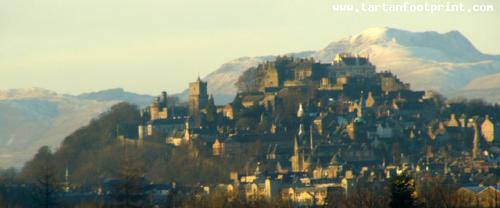You seem to be using an older version of Internet Explorer. This site requires Internet Explorer 8 or higher. Update your browser here today to fully enjoy all the marvels of this site.
November 12, 2018 by Alexander Meldrum
Scotlands Citys
Stirling
The Wolf Craig Seal. The ancient coat of arms of Stirling also show a wolf upon a rock above a stream.
Stirling (/'st??rl??/; Scots: Stirlin; Scottish Gaelic: Sruighlea...Scotlands Citys
Stirling
The Wolf Craig Seal. The ancient coat of arms of Stirling also show a wolf upon a rock above a stream.
Stirling (/'st??rl??/; Scots: Stirlin; Scottish Gaelic: Sruighlea ['s?t??u?l?]) is a city in central Scotland.
The market town, surrounded by rich farmland, grew up connecting the royal citadel, the medieval old town with its merchants and tradesmen, the bridge and the port.
Located on the River Forth, Stirling is the administrative centre for the Stirling council area, and is traditionally the county town of Stirlingshire. Proverbially it is the strategically important "Gateway to the Highlands".
It has been said that "Stirling, like a huge brooch clasps Highlands and Lowlands together". Similarly "he who holds Stirling, holds Scotland" is often quoted.
Stirling's key position as the lowest bridging point of the River Forth before it broadens towards the Firth of Forth, made it a focal point for travel north or south.
When Stirling was temporarily under Anglo-Saxon sway, according to a 9th-century legend, it was attacked by Danish invaders. The sound of a wolf roused a sentry, however, who alerted his garrison, which forced a Viking retreat.
This led to the wolf being adopted as a symbol of the town as is shown on the 1511 Stirling Jug. The area is today known as Wolfcraig.
Even today the wolf appears with a goshawk on the council's coat of arms along with the recently chosen motto: "Steadfast as the Rock".
Once the capital of Scotland, Stirling is visually dominated by Stirling Castle. Stirling also has a medieval parish church, the Church of the Holy Rude, where, on 29 July 1567, the infant James VI was anointed King of Scots by the Bishop of Orkney with the service concluding after a sermon by John Knox.
The poet King was educated by George Buchanan and grew up in Stirling. He was later also crowned King of England and Ireland on 25 July 1603, bringing closer the countries of the United Kingdom.
Modern Stirling is a centre for local government, higher education, tourism, retail, and industry. The mid-2012 census estimate for the population of the city is 36,440; the wider Stirling council area has a population of about 93,750.
One of the principal royal strongholds of the Kingdom of Scotland, Stirling was created a royal burgh by King David I in 1130. In 2002, as part of Queen Elizabeth's Golden Jubilee, Stirling was granted city status.
History
A stone cist, found in Coneypark Nursery in 1879, is Stirling's oldest catalogued artefact. Bones from the cist were radiocarbon dated and found to be over four millennia old, originating within the date range 2152 to 2021 BC.
Nicknamed Torbrex Tam, the man, whose bones were discovered by workmen, died while still in his twenties. Other Bronze Age finds near the city come from the area around Cambusbarron.
It had been thought that the Randolphfield standing stones were more than 3000 years old but recent radiocarbon dating suggests they may date from the time of Bruce.
The earliest known structures on Gillies Hill were built by Iron Age people over 2000 years ago. Two structures are known: what is currently called Wallstale Dun on the southern end of Touchadam Craig, and Gillies Hill fort on the northwest end of the craig.
South of the city, the King's Park prehistoric carvings can still be found.Whether the ancient Maeatae or Manaw Gododdin tribes settled in Stirling is not clear.
The Auld Brig at Stirling
The castle rock has been strategically significant since at least the Roman occupation of Britain, due to its naturally defensible crag and tail hill: the bedrock on which Stirling Castle was built.
However, if the Romans were ever on the current castle site then they didn't leave more than a coin or two. Nevertheless, Stirling enjoys a unique position on the border between the Lowlands and Highlands.
Go to Wikipedia for full History
In this photo:


